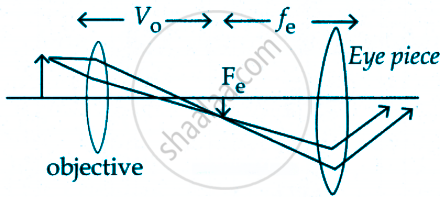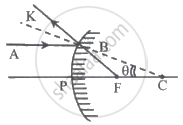Advertisements
Advertisements
Question
A compound microscope has a magnifying power of 100 when the image is formed at infinity. The objective has a focal length of 0.5 cm and the tube length is 6.5 cm. What is the focal length of the eyepiece.
Solution
`"v"_circ + "f"_"e"` = 6.5 cm ....(1)
m = `"v"_circ/"u"_circ xx "D"/"f"_"e"` [taking D = 25 cm]
`=> "m" = - [1 - "v"_circ/"f"_circ] "D"/"f"_"e"`
`100 = - [1 - "v"_circ/0.5] 25/"f"_"e"`
`100 "f"_"e" = - (1 - 2"v"_circ) xx 25`
`2"v"_circ - 4 "f"_"e" = 1` .....(2)
Solving equation (1) and (2) we can get,
v0 = 4.5 cm and fe = 2 cm

APPEARS IN
RELATED QUESTIONS
Answer the following question in detail.
How does magnifying power differ from linear or lateral magnification?
Answer the following question in detail.
Obtain the expressions for magnifying power and the length of an astronomical telescope under normal adjustments.
Answer the following question in detail.
What is the limitation in increasing the magnifying powers of a simple microscope?
Discuss about simple microscope and obtain the equations for magnification for near point focusing and normal focusing.
Why is oil-immersed objective preferred in a microscope?
What are the advantages and disadvantages of using a reflecting telescope?
What are the uses of spectrometer?
What is myopia?
What is the remedy of myopia?
What is hypermetropia?
Discuss about simple microscope and obtain the equations for magnification for near point focusing and normal focusing.
Obtain the equation for resolving the power of the microscope.
Discuss about astronomical telescope.
Mention different parts of the spectrometer.
The near point and the far point for a person are 50 cm and 500 cm, respectively. Calculate the power of the lens the person should wear to read a book held in hand at 25 cm. What maximum distance is clearly visible for the person with this lens on the eye?
If astronomical telescope of length 1.53 m has magnifying power of magnitude 50, the values of fo and fe are ____________.
The magnifying power of a telescope is nine. When it is adjusted for parallel rays, the distance between the objective and eyepiece is 20 cm. The focal length of objective and eyepiece are respectively.
In the adjoining figure, AB represents the incident ray, and BK is the reflected ray. If angle BCF = θ, then ∠BFP is given by ______.

A camera objective has an aperture diameter of d. If the aperture is reduced to diameter d/2, the exposure time under identical conditions of light should be made ______.
